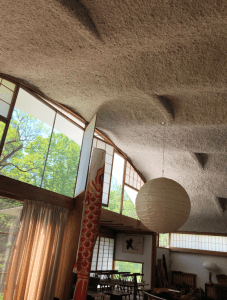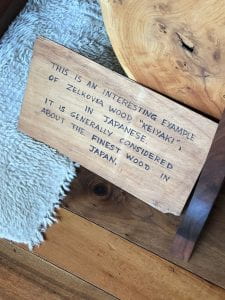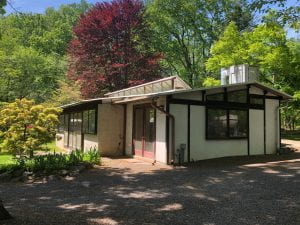George Nakashima Was Born Today…And So Was I
By Carrie Greif, WPAMC Class of 2019
George Nakashima was born today, May 24, in 1905. Through some cosmic coincidence, 85 years later on that same day, I was born. Nakashima is one of the most important craftsmen of the 20th century. I am not. I shouldn’t be allowed within an arm’s reach of a saw without careful supervision. But like countless other people, I feel connected to him and to his work. A National Parks Ranger said I should go to Nakashima’s Workshop, so I did. You should too. Read on to find out why.

A photograph of George Nakashima outside his studio circa 1955. Photo courtesy of George Nakashima’s Workshop.
There is no one to greet you when you arrive at George Nakashima’s Workshop in New Hope, Pennsylvania. There’s no Visitor Center or welcome mat. The compound emerges after a sharp turn off a steep hill. Windows down, music blaring, I checked the address twice before turning into the unmarked lot. I shimmied my car between two others and hopped out to take in the vista. Immediately, I got the identifiable whiff of a carefully crafted environment that is much better felt than described.
When Nakashima decided to become a craftsman, he already had a graduate degree in Architecture from MIT. He had lived in Paris, Japan and on an Ashram in India. He returned to the United States in 1940 and married his wife Mira in Los Angeles. In 1941 they were interned following the bombing of Pearl Harbor. They lived at a camp in Idaho for over a year. While at the camp, George trained and collaborated with Japanese woodworkers learning ancient techniques. Some of his earliest designs were expressed in forms made from scraps found around the camp. Mira still has a box he made her during their time there. In 1943 George was sponsored by a close friend and fellow architect, Antonin Raymond, who lived in New Hope, Pennsylvania. Once there, George began his life’s work as a woodworker and never left.
Mira is still in New Hope, and she continues her husband’s practice and business. I met her in a shaded gallery that previously served as the family living room. The room is everything you want from Japanese-infused American modernism. White curved cement, incredible wide plank floors, daringly large windows – it’s perfect. Having seen Nakashima pieces in galleries before, I was awestruck to see them in their natural habitat. Here, they sing.

The floor in the Nakashima living room turned gallery. Photo taken by the author.

Ceiling in the Nakashima living room-turned-gallery. Photo taken by the author.

The Nakashima living room turned gallery. Photo taken by the author.
I asked Mira if she had seen a Keiyaki tree in person while we both stood in front of a sculpture made from a Keiyaki trunk. Keiyaki tree trunks can grow approximately 10 feet in diameter and the trees live to be 1200 years old. They are some of the oldest things alive on this earth. George Nakashima greatly admired these trees and strove to offer a second life through his art to those that gave up during his lifetime. Mira serenely responded that she had seen Keiyaki trees – and that I should go to Japan to visit them myself.

A closeup of the Keiyaki tree trunk, showing the close grain and figured details in the wood. Photo taken by the author.

Label on the trunk of the Keiyaki tree trunk. Photo taken by the author.
George Nakashima said of his work:
“There is mystery in the creative process and its relation to craft; the infinite moves into dark waters. To find an answer to problems as we see them, to see solutions and produce objects in space, to fulfill man’s needs with a touch of beauty, to use material dear to nature, making small answers with useful things – since my earliest experience as a woodworker, all this has been my destiny.”
For the Nakashimas, the role of the woodworker is to, “shape the wood to realize its true potential.” The studio embraces cracks, knotholes, and gnarled lumber. Traditions from East and West are designed to merge through objective form. Nakashima’s modern butterfly joints float through solid planks. What could be seen as imperfections of the wood are highlighted by Nakashima in a way that makes them beautiful elements of each work.
You can see his work in museums and collections around the world. But you can only see an interior space he designed in New Hope. When you get to the Nakashima Workshop, you will be able to wander through at least four spaces. Two are functioning wood shops that are still crucial elements in the production of Nakashima furniture. Two previously served as the family’s residence and now serve as galleries.

The woodworking studio at George Nakashima’s Workshop in New Hope, Pennsylvania. Photo taken by the author.
The details of these spaces will remain a tantalizing mystery for you to discover. If I have learned anything from the Nakashimas it is that we should strive to guide and not instruct. Mystery can be frustrating for a visitor. As an anxious graduate student with a blog deadline, I felt that when I first arrived at the Nakashima compound. But, if all we want are facts we are best served by staying in our homes and reading Wikipedia articles. If feelings or expressions are what we are after, then we need to get up and go out. We have to go smell some things we didn’t anticipate. We need to follow the Nakashimas, look mystery in the eye, and say, “I don’t know you and that’s why you’re beautiful.”

Leave a Reply